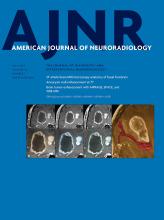Index by author
Zhang, X.
- Adult BrainOpen AccessNormal-Appearing Cerebellar Damage in Neuromyelitis Optica Spectrum DisorderJ. Sun, N. Zhang, Q. Wang, X. Zhang, W. Qin, L. Yang, F.-D. Shi and C. YuAmerican Journal of Neuroradiology July 2019, 40 (7) 1156-1161; DOI: https://doi.org/10.3174/ajnr.A6098
Zhang, Y.
- PediatricsYou have accessQuantitative Analysis of Punctate White Matter Lesions in Neonates Using Quantitative Susceptibility Mapping and R2* RelaxationY. Zhang, A. Rauscher, C. Kames and A.M. WeberAmerican Journal of Neuroradiology July 2019, 40 (7) 1221-1226; DOI: https://doi.org/10.3174/ajnr.A6114
Zhang, Z.
- Adult BrainOpen AccessQuantitative Delta T1 (dT1) as a Replacement for Adjudicated Central Reader Analysis of Contrast-Enhancing Tumor Burden: A Subanalysis of the American College of Radiology Imaging Network 6677/Radiation Therapy Oncology Group 0625 Multicenter Brain Tumor TrialK.M. Schmainda, M.A. Prah, Z. Zhang, B.S. Snyder, S.D. Rand, T.R. Jensen, D.P. Barboriak and J.L. BoxermanAmerican Journal of Neuroradiology July 2019, 40 (7) 1132-1139; DOI: https://doi.org/10.3174/ajnr.A6110
Zhao, H.
- Adult BrainOpen AccessAssociation of Fractional Flow on 3D-TOF-MRA with Cerebral Perfusion in Patients with MCA StenosisX. Ge, H. Zhao, Z. Zhou, X. Li, B. Sun, H. Wu, J. Wan, J. Xu, J.P. Villablanca and X. LiuAmerican Journal of Neuroradiology July 2019, 40 (7) 1124-1131; DOI: https://doi.org/10.3174/ajnr.A6095
Zhou, Z.
- Adult BrainOpen AccessAssociation of Fractional Flow on 3D-TOF-MRA with Cerebral Perfusion in Patients with MCA StenosisX. Ge, H. Zhao, Z. Zhou, X. Li, B. Sun, H. Wu, J. Wan, J. Xu, J.P. Villablanca and X. LiuAmerican Journal of Neuroradiology July 2019, 40 (7) 1124-1131; DOI: https://doi.org/10.3174/ajnr.A6095
Zuber, K.
- FELLOWS' JOURNAL CLUBAdult BrainYou have accessDiagnosis and Prediction of Relapses in Susac Syndrome: A New Use for MR Postcontrast FLAIR Leptomeningeal EnhancementS. Coulette, A. Lecler, E. Saragoussi, K. Zuber, J. Savatovsky, R. Deschamps, O. Gout, C. Sabben, J. Aboab, A. Affortit, F. Charbonneau and M. ObadiaAmerican Journal of Neuroradiology July 2019, 40 (7) 1184-1190; DOI: https://doi.org/10.3174/ajnr.A6103
From January 2011 to December 2017, nine consecutive patients with Susac syndrome and a control group of 73 patients with multiple sclerosis or clinically isolated syndrome were included. Two neuroradiologists blinded to the clinical and ophthalmologic data independently reviewed MRIs and assessed leptomeningeal enhancement and parenchymal abnormalities. Follow-up MRIs of patients with Susac syndrome were reviewed and compared with clinical and retinal fluorescein angiographic data evaluated by an independent ophthalmologist. Patients with Susac syndrome were significantly more likely to present with leptomeningeal enhancement: 5/9 (56%) versus 6/73 (8%) in the control group. They had a significantly higher leptomeningeal enhancement burden with ≥3 lesions in 5/9 patients versus 0/73. Regions of leptomeningeal enhancement were significantly more likely to be located in the posterior fossa. The authors conclude that leptomeningeal enhancement occurs frequently in Susac syndrome and could be helpful for diagnosis and prediction of clinical relapse.








